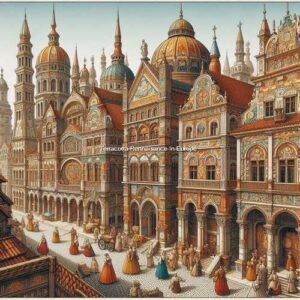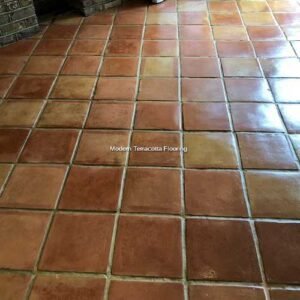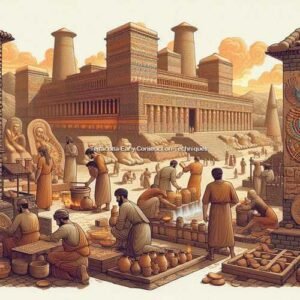Terracotta tiles have a long-standing presence in architecture and design, boasting a fascinating heritage encompassing various cultures and eras. These tiles have proven durable and adapted to changing trends, making them a popular choice for a wide range of uses. In this blog post, we will delve into the intriguing history of Terracotta and explore its widespread applications in modern design.
Ancient Origins: Discovering the Roots of Terracotta Tiles
Origins in Mesopotamia
Terracotta, a material used in construction for centuries, derives its name from the Italian phrase “baked earth.” Its origins can be traced back to the 3rd millennium BC in Mesopotamia, where it was commonly used to construct dwellings and temples. These tiles are perfect for such purposes due to their durability and natural beauty.
In ancient Mesopotamia, Terracotta served a dual purpose—it was not only functional but also carried deep symbolic meaning. The Assyrians and Babylonians extensively used Terracotta to construct palaces and religious sites. Its application served functional and ornamental purposes, highlighting its immense aesthetic and cultural value.
Construction Methods from the Past
The early utilisation of Terracotta in Mesopotamia established the foundation for its lasting impact. Builders in Mesopotamia were well aware of the material’s remarkable durability in the face of harsh weather conditions. Creating Terracotta involves shaping clay into desired forms and firing it at high temperatures for a hardened, durable product. This technique has remained virtually the same for millennia.
Evolution in Mediterranean Cultures: The Rise of Terracotta in Greece and Rome
Greece In Antiquity
Terracotta became widely used in the Mediterranean cultures of Greece and Rome, valued for its practicality and pleasing appearance. During ancient times in Greece, Terracotta was a popular material for constructing temples and public buildings. Greek architects excelled in working with Terracotta, creating elaborately shaped tiles arranged in intricate designs.
Advancements in Ancient Rome
The Romans made significant advancements in terracotta tile production techniques. They introduced moulds to ensure uniformity and experimented with various shapes, designs, intricate patterns, and pictorial motifs. Roman builders widely used Terracotta across multiple construction projects, including villas, public baths, and theatres. The development of interlocking roof tiles, known as “tegulae” and “imbrices,” was a remarkable Roman innovation.
Significance in Culture
Terracotta tiles in Roman architecture frequently showcased depictions of mythology and everyday life, reflecting the cultural values and artistic accomplishments of the era. The durability of Terracotta has ensured that many structures have stood the test of time, enabling modern observers to admire the skill of ancient builders.
 Terracotta Renaissance in Europe: Reviving an Ancient Craft
Terracotta Renaissance in Europe: Reviving an Ancient Craft
A New Beginning In The Renaissance
There was a renewed interest in Terracotta during the Renaissance era in Europe. Architects and designers have embraced this versatile material to bring a touch of sophistication to their projects. The tiles beautifully decorated the exteriors of magnificent structures, including grand buildings, churches, and palaces, demonstrating their capacity to elevate visual appeal while offering insulation and safeguarding.
Renowned Renaissance architects, such as Brunelleschi and Michelangelo, skillfully integrated Terracotta into their architectural masterpieces, appreciating its ability to create intricate and captivating exteriors.
Technical and Artistic Advancements
The Renaissance was a time of remarkable technology and art progress. Artisans perfected innovative glazing methods that infused terracotta tiles with rich hues and a lustrous sheen, elevating their allure.
Influence on European Architecture
The extensive use of Terracotta during the Renaissance greatly influenced European architecture, which persisted throughout the Baroque and Rococo eras.
Terracotta in Contemporary Design: Embracing Tradition in Modern Spaces
Modern Applications
Today, Terracotta continues to be popular in contemporary design. Their natural earthy tones and rustic charm lend warmth and character to indoor and outdoor spaces. In modern interior design, terracotta floors create a cosy and inviting atmosphere, often used in kitchens, living rooms, and bathrooms.
Sustainable and Eco-Friendly Choice
Terracotta floors are an eco-friendly option for sustainable building practices. Made from natural clay, they are biodegradable and have a low environmental impact. Their production process requires less energy than other building materials, and their durability means they have a long lifespan, reducing the need for frequent replacements.
Innovative Design Trends
Recent design trends have seen a resurgence in the use of Terracotta, with designers and architects exploring new ways to incorporate this timeless material into their projects. Terracotta tiles easily suit contemporary tastes, from geometric patterns and bold colours to minimalist and industrial aesthetics.
 Common Uses and Applications: Versatile and Functional Terracotta Tiles
Common Uses and Applications: Versatile and Functional Terracotta Tiles
Floor Covering
Terracotta can create captivating feature walls that enhance any room’s texture and visual appeal. They are highly effective in spaces that strive for a rustic or Mediterranean-inspired look.
Wall Covering
Terracotta can create stunning feature walls, adding texture and visual interest to any room. They work exceptionally well in spaces aiming for a rustic or Mediterranean-inspired aesthetic.
Roofing Material
Terracotta is a highly durable material, making it excellent for roofing. Terracotta offers exceptional protection from the elements while adding a unique charm to any building.
Stylish Embellishments
Terracotta tiles are famous for decorative accents in various architectural elements, including arches, columns, and cornices. Their adaptability enables designers to craft one-of-a-kind and visually captivating elements.
Landscape And Garden Use
Terracotta tiles are a great choice for enhancing the aesthetic appeal of garden paths, courtyards, and poolside areas. They bring a touch of natural beauty to outdoor spaces, and their earthy tones and textured surfaces effortlessly harmonise with the surrounding natural environment.
FAQs About Terracotta Tiles
What advantages do terracotta tiles offer in sustainable architecture?
Terracotta tiles are crafted with the utmost care, using natural clay, ensuring their eco-friendly nature and minimal environmental impact. With their exceptional durability and impressive lifespan, there is no need for frequent replacements.
What are some ways to improve the colour of terracotta tiles?
Consistent cleaning and effective sealing can help to enhance the colour. Utilising a colour-enhancing sealer can further accentuate the inherent shades.
Are there any current design trends for terracotta tiles?
Indeed, contemporary design incorporates geometric patterns and vibrant colours and seamlessly blends with minimalist and industrial aesthetics.
What are the recommended methods for installing terracotta tiles?
Proper surface preparation, selecting the appropriate adhesive, and allowing ample drying time are crucial for optimal results. Expert installation guarantees a secure and reliable placement.
Is it possible to utilise terracotta tiles for heated flooring systems?
Indeed, terracotta tiles are well-suited for heated flooring systems, ensuring effective heat distribution and a pleasant temperature.
Relevant Hyperlinked Sources
The post: Terracotta Tiles: A Fascinating Journey Through History and Time appeared first on TileCleaningSurrey.co.uk
The Article Terracotta Tiles: An Engaging Exploration of the Past and Present appeared first on https://fabritec.org
The Article Terracotta Tiles: An Engaging Exploration of the Past and Present Was Found On https://limitsofstrategy.com




Fascinating stuff! It’s wild to think that while we’re busy debating the merits of quartz vs. granite countertops, ancient Assyrians were crafting elegant terracotta tiles for their temples. Talk about setting the bar high! I love how terracotta combines sheer practicality with a sense of heritage—it’s like the ultimate “vintage-chic” flooring choice. Plus, with modern home decor trends leaning heavily on natural materials, I wonder if those ancient craftspeople would roll their eyes or nod approvingly at our obsession. I mean, who needs fancy, synthetic tiles when you can channel your inner Mesopotamian architect? Let’s keep the conversation going—anyone thinking of incorporating terracotta in their next home project?
It’s true that the artistry of ancient civilizations like the Assyrians speaks volumes about the timeless nature of design and craftsmanship. Terracotta really does blend practicality with heritage, offering warmth and a certain character that synthetic materials can struggle to replicate.
I appreciate your perspective on the artistry of ancient civilizations and the unique qualities of terracotta. There’s something incredibly grounding about the materials we use, isn’t there? Terracotta not only embodies a rich cultural history, but it also connects us to our environment in a way that synthetic materials sometimes fail to do. I often think about how the choices we make in design reflect our values and priorities.
It really is intriguing to think about how different materials reflect not just aesthetic choices, but also cultural values and historical contexts. You’re right—while we are preoccupied with contemporary trends, those ancient Assyrians were investing their artistry into something so enduring like terracotta. It feels like a commitment to both the environment and craftsmanship that we might all learn from today.
You’re spot on about the connection between materials and cultural values. It’s fascinating how ancient societies like the Assyrians had such a profound understanding of their environment and resources. Terracotta wasn’t just a practical choice for them; it was a canvas for storytelling, a way to convey their beliefs and daily lives.
You bring up such an interesting point about how materials reflect deeper values and narratives in our history. It’s fascinating to consider how the use of terracotta by the Assyrians wasn’t just about functionality, but about connection—to the earth, to their culture, and to their artistry. I often think about how, in our current age, we might sometimes overlook the stories that materials can tell.
You make an important observation about the connection between materials and the stories they tell. The Assyrians’ use of terracotta demonstrates a relationship that goes beyond mere utility—it’s an expression of identity and creativity. It’s intriguing to think that today, while we often chase after the latest technologies, we might be distancing ourselves from the powerful narratives woven into the materials around us.
You bring up an essential point about the interplay between materials and cultural narratives. When we look at terracotta from ancient civilizations like the Assyrians, it’s fascinating to consider how their choices went beyond mere functionality. They were shaping their environment and leaving a legacy that speaks to their societal values. This is something we often overlook in our fast-paced contemporary context, where trends come and go almost overnight.
You’ve highlighted an intriguing aspect of how materials can inform cultural narratives, and it’s a point that deserves deeper examination. When we take a look at the terracotta used by ancient civilizations like the Assyrians, we see more than just the physical attributes of the clay. The way these cultures employed terracotta speaks volumes about their priorities, values, and historical context. They weren’t just using materials to create objects; they were crafting stories and expressing identities.
It’s fascinating to think about how terracotta tiles have transcended time and culture, serving not just utilitarian purposes but also embodying the aesthetic values of their eras. The way ancient civilizations like the Assyrians and Babylonians imbued these materials with symbolic meaning is particularly intriguing. I find it remarkable how this “baked earth” connects us to our past and influences contemporary design.
You’ve made some great points about terracotta tiles and their rich history. It’s interesting how a simple material can carry so much weight in terms of cultural symbolism and aesthetic value. I recently read about how terracotta was not only used for flooring but also as a medium for artwork, like in the intricate bas-reliefs of ancient Mesopotamia. It’s fascinating how these expressions of creativity often served practical purposes while also telling stories and signifying status.
It’s really intriguing how materials like terracotta can encapsulate such a blend of artistry and practicality. When you mentioned the bas-reliefs of Mesopotamia, it struck me how those ancient artisans were not just creating art for art’s sake; they were embedding their culture’s narratives and values into every piece. It’s almost like they knew that future generations, just like us, would be compelled to find meaning in those works.
It’s fascinating to consider how terracotta served not only as a medium for artistic expression but also as a canvas for storytelling in ancient civilizations. The use of bas-reliefs in Mesopotamia truly exemplifies this dual role. Those artisans, working with their hands and tools, were actually crafting narratives that would resonate through time, shaping the understanding of their culture, beliefs, and daily lives.
It’s intriguing to think about how materials like terracotta bridge the gap between function and artistry. The idea that something as utilitarian as flooring can also serve as a canvas for storytelling really highlights the creativity of ancient cultures. Those intricate bas-reliefs in Mesopotamia aren’t just visually captivating; they also provide a glimpse into the socio-political dynamics of the time.
I really enjoyed reading about the rich history of terracotta tiles—it’s fascinating how something so seemingly simple can have such deep cultural significance. It makes me think about how our choices in materials and design can reflect our heritage and values. The fact that terracotta has been used since ancient Mesopotamia not only speaks to its durability but also to its versatility in terms of aesthetics and function.
It’s fascinating to think about how terracotta tiles have not only stood the test of time in terms of durability but also in their cultural significance. In many ways, they symbolize the intersection of functionality and artistry throughout history. For instance, the use of terracotta in places like ancient Greece and Rome wasn’t just about aesthetics; it also reflected the societal values at the time, where craftsmanship and nature were deeply intertwined.
You’ve hit on something really interesting with the cultural significance of terracotta tiles. It’s amazing to see how these materials weren’t just utilitarian but were woven into the very fabric of life in ancient societies. When we think about places like Greece and Rome, it makes sense that their use of terracotta reflected not only craftsmanship but also a deep connection to nature and the environment around them.
I’ve always been fascinated by how materials like terracotta can carry such rich histories and meanings through the ages. It’s incredible to think of the ancient Mesopotamians using terracotta not just for its durability, but also as a symbolic element in their structures. It makes me wonder how many of our modern designs will be viewed a few centuries from now—will they be celebrated for their aesthetics, or perhaps even for environmental sustainability?
It’s fascinating to consider how materials like terracotta not only serve practical purposes but also embody the cultural and artistic expressions of their time. The ancient Mesopotamians certainly understood the dual significance of their materials, using terracotta for everything from pottery to architectural elements, often inscribing their beliefs and stories into them.
It’s interesting you mention the symbolic role of materials like terracotta in ancient architecture. I think it speaks volumes about how our ancestors viewed the world around them, using not just the practical aspects of materials but also imbuing their environments with deeper meanings. In fact, the way terracotta featured in everything from pottery to bricks tells us a lot about their culture and values at that time.
You bring up such an interesting point about terracotta and its layered significance throughout history. There’s something really captivating about how materials can act as storytellers, carrying the essence of the cultures that produced them. When we look at ancient Mesopotamia, terracotta wasn’t just a practical choice; it had a role in rituals, art, and even governance. The way those early societies integrated material with meaning is something we can learn from today.
You’ve touched on something quite profound with your reflection on terracotta and how materials can encapsulate the cultural mindset of their time. When we look at ancient Mesopotamia, it’s clear that terracotta wasn’t just a practical choice; it served deeper purposes, ranging from the functional aspects of clay’s workability to its participation in rituals and daily life—a vessel for both utility and meaning.
You’ve raised an interesting point about the multifaceted nature of terracotta—it’s like the Swiss Army knife of ancient materials. On the surface, it might seem like just clay that was shaped and baked, but when you dig deeper, you realize it’s a colorful tapestry woven into the daily lives and beliefs of people in ancient Mesopotamia.